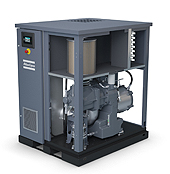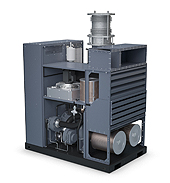![]() Text
as rtf file
Text
as rtf file
![]() Text
as pdf file
Text
as pdf file
![]() Photos
Photos
Atlas Copco at IFAT in Munich (4 to 8 May 2020)
Screw blowers operate with a consistently high efficiency of 97%
With Atlas Copco's efficient screw, turbo and lobe blowers, wastewater treatment plant operators can drastically reduce their energy costs for aeration tasks. At the IFAT trade fair, which is being held in Munich in May, Atlas Copco presents its latest technologies.
Essen, February 2020. Atlas Copco is presenting new, particularly efficient turbo, screw and lobe blowers for wastewater technology at the IFAT. The world's leading trade fair for water, wastewater, waste and raw materials management takes place in Munich from 4 to 8 May. At stand A3.345 in the "water treatment hall" A3, Atlas Copco will be focusing on its new, oil-free screw blower ZS 4 VSD+. This machine works very efficiently and is suitable for the aeration in the biological tanks of municipal and industrial wastewater treatment plants.
The high efficiency levels of the ZS 4 VSD+ are achieved thanks to features such as a permanent magnet motor that fulfils the reference values of the IE5 efficiency class. The blowers have a virtually constant efficiency of 97% over their entire control range - also in part-load operation. The units are operated with Atlas Copco's self-developed Neos frequency inverter which runs the motors with the latest variable speed drive technology (VSD+). This leads to increased efficiency even with fluctuating loads, reducing the energy consumption of the ZS blowers by up to 10% compared with their predecessors. The blowers are available with ratings from 37 to 90 kW and generate TÜV-certified, absolutely pure compressed air according to ISO 8573-1, class 0 (2010).
"This new generation of ZS VSD+ blowers is one of the most energy-efficient solutions for oil-free screw blowers on the market," Lisa-Marie Grzeskowiak says, the product manager for low-pressure solutions with Atlas Copco in Essen. With its new screw element, the ZS 4 VSD+ reaches gauge pressures of up to 1.5 bar. "These blowers have such a compact design that they take up only about half as much space as their predecessors with similar ratings," she adds. "This means that the blowers can be installed in any compressor room and can be easily positioned using a forklift truck." With the ZS 4 VSD+, pressure and temperature are continuously monitored, ensuring high reliability and efficiency. The screw blowers operate with a single-stage, direct-driven screw element and use up to 30% less energy than a lobe blower thanks to internal compression. Their wide control range means they work very efficiently even with fluctuating loads.
Turbo blowers might be even more economical in the long run
As a second innovation, which will also be presented at the IFAT, Grzeskowiak mentions the variable-speed drive turbo blowers of the ZB 5-6 VSD+ series. "Our turbos are are extremly efficient and, under certain conditions, in the long run even more economical than the screw blowers", Grzeskowiak reports. The new ZB series has been developed for low-pressure applications with pressure boosts up to 1.4 bar. The turbo blowers are available with volume flow rates between 2000 and 11000 m3/h and feature motors with magnetic, i. e. contactless, bearings. This eliminates bearing friction, which prevents vibrations and reduces wear. Very low maintenance costs and an extremely low sound pressure level are the positive effects. "Compared to other technologies, our customers can achieve energy savings of 30 to 60 percent," the product manager says.
The initial investment is higher for the turbos, but users will eventually recoup the money through the lower electricity bill. "The machines particularly show their advantages where high volume flow rates are required," says Lisa-Marie Grzeskowiak. "Under these conditions, turbos can work more efficiently than screw blowers, at least when the compressed air requirement is relatively constant, meaning little regulation is required." In case of higher fluctuations with a wide control range screw blowers are usually the better solution.
The ZB 5-6 VSD+ have integrated VSD+ variable-speed drive motors as well, meaning the blowers can continuously adapt the volume flow rate to the requirements of the individual process. This enables a demand-oriented air supply with low energy consumption with correspondingly low life cycle costs of the ZB turbos. Like the ZS screw blowers, the ZB turbos are certified for their oil-free compression in accordance with ISO 8573-1:2010, class 0. This means that no oil is fed into the process by the blower, which minimizes the risk of contamination of the wastewater.
A combination of turbo and screw blowers allows wide control ranges plus a maximum of energy efficiency
If wide control ranges and a maximum of energy efficiency are required, Grzeskowiak recommends installing a ZB VSD+ turbo together with a ZS screw: "This drastically reduces running costs without having to sacrifice flexibility and controllability." Which compressor technology or machine combination makes the most sense depends on actual requirements. "An AIRScan in advance of the project gives you the security you need for planning," suggests Grzeskowiak. "During an AIRScan, we measure the actual volume flow rates during operation, the compression required as well as the control ranges. Then we simulate the system using the latest blower units." The result is an overview indicating the savings potential in terms of kilowatt-hours and euros for the operator.
New oil-free lobe blowers for low initial investment
In addition to screw and turbo blowers, Atlas Copco also offers the robust lobe blowers of the new ZL series for water treatment. "In physical terms, these units are not as efficient as screw blowers, but they are very inexpensive," Lisa-Marie Grzeskowiak says. "In addition, the ZL units are extremely reliable and have very low maintenance requirements." The blower is supplied as a unit complete with controller and inverter, which stands for an easy installation. The inverter integrated in the system is programmed ready for use and adapted to the lobe blower. This makes installation easier for the user as there is no need for separate installation, wiring or programming of the inverter.
Lower power costs justify the higher purchase price
Which system is the best for a wastewater treatment plant and which is most efficient over its lifespan cannot be lumped together. "But since we offer all technologies from a single source, we can advise our customers independently of the respective advantages and disadvantages," emphasizes Lisa-Marie Grzeskowiak. For pressure increases below 450 mbar, a lobe blower could be considered. "Our ZL lobe blowers boost the air pressure by between 300 and 1000 mbar and are available with power requirements from 1.1 to 315 kW in finely graduated stages," the product manager adds. "Modern screw blowers such as the ZS, however, require less energy, thus reducing electricity costs. The lower power costs justify the higher purchase price and the additional investment is recouped in a very short space of time." For pressure increases of 450 mbar and more, she generally recommends ZS screw blowers - and, given the right conditions, the turbos or a combination of the technologies.
 |
Download: |
 |
Download: |